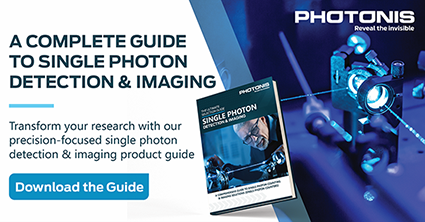Image intensifiers solutions for single photon counting applications
Single photon counting and imaging are techniques used to detect, measure and visualize extremely weak light signals, down to single photons. Photonis part of Exosens, single photon detectors are used in a range of applications, such as High end LIDAR, Quantum optics and Quantum telecommunication, High energy physics, Particle physics, Nuclear physics, Fluorescence imaging, Astronomy, Plasma research and others. To detect single photon signals, Photonis proposes various types of high-sensitivity, fast-timing, low-noise, vacuum tube-based single photon detectors for OEM and end-user applications. Our team of experts provide support and consulting services to help select and implement the right single photon detector for applications such as space based High end LIDAR and others.
Photonis multialkali Hi-QE photocathode technology combines a high quantum efficiency (QE) in the 120-1050 nm spectral range, with a dark count rate as low as 50 Hz/cm², thereby achieving a superb signal to noise ratio. When the photocathode is utilized as an ultra-fast electro-optical shutter, sub nanosecond (billionth of a second) gating speeds can be achieved for accurate transient phenomena imaging. Photonis single photon detectors are based on patented high end microchannel plate (MCP) technology offering a high dynamic range and an unmatched collection efficiency of >95%.
Discover our Complete guide to Single Photon Detection & Imaging by clicking below:
Dive into the world of single photon detector to understand and leverage the power of cutting-edge photon detection technologies. Explore further below to learn more about photon detection technology, benefits, and our cutting-edge solutions:
- Learn more about single photon detector
- Overcoming the technical challenges of single photon detection
- Redefining single photon detection technology
- Technical challenges of single photon detection
- Exploring visible technology
- Learn more about image intensifiers for scientific applications
- Read more about ions & electrons detection technology
- Discover Photonis photo-detection and low light conditions imaging Solution
About single photon detector
In the cutting-edge world of photonics, the detection, measurement, and visualization of single photons stand as paramount endeavors. Photonis, part of Exosens, employs state-of-the-art technologies to offer a variety of tailored solutions for high precision applications, enabling sensitive measurements, quantum information processing, fundamental research, and imaging in various scientific and technological fields.
Photonis is a leading provider of cutting-edge technology for single photon counting, detection, and imaging. Our expertise in this technique is essential for various industries, such as high-end LIDAR, quantum optics, high energy physics, and astronomy. At the core of our offerings are highly advanced single photon detectors designed with precision to provide unmatched sensitivity, precise timing, and effective noise reduction.
At the core of Photonis' revolutionary advancements in single photon detection is the innovative multialkali Hi-QE photocathode technology, renowned for exceptional quantum efficiency across the infrared spectrum. This technology not only ensures maximum absorption of photons but also minimizes afterpulsing phenomena, resulting in pristine signal integrity even in demanding environments. Moreover, meticulous temperature and voltage control mechanisms guarantee optimal performance, pushing the boundaries of single photon detection to new heights.
Our commitment to excellence extends to the core principles of our vacuum tube-based detector technology. Through the ingenious integration of microchannel plate (MCP) technology, Photonis achieves an active area that maximizes photon capture efficiency while mitigating dark counts to negligible levels. This meticulous process ensures that every pulse is accurately detected, providing researchers with confidence in their measurements.
For applications demanding real-time imaging of transient phenomena, our detectors offer pulse gating speeds in the sub-nanosecond range, enabling precise visualization of even the most fleeting events. Furthermore, our detectors excel in high-energy environments, where robustness and reliability are paramount, making them indispensable tools in particle physics and plasma research.
In the realm of single photon counting, accuracy is crucial. Photonis' MCP-PMT detectors are meticulously engineered to deliver exceptional sensitivity and low noise performance. By harnessing the power of microchannel plates, these detectors excel in capturing individual photons with maximum efficiency, making them indispensable in fields such as medical imaging and nuclear physics.
Beyond single photon counting, Photonis leads the forefront in single photon imaging technology. Through the utilization of Image Intensifier Tubes (IITs), our solutions offer unprecedented sensitivity, allowing for the detection and imaging of individual photons in a variety of applications. Whether in quantum optics or astronomical observation, our IIT-based imaging systems provide researchers with the tools they need to push the boundaries of scientific discovery.
The afterpulsing rate of our detectors is meticulously controlled, ensuring accurate measurements even in high-activity environments.
By carefully managing the flow of current within the device, we optimize its performance and longevity.
Sophisticated cooling mechanisms are integrated into our systems to maintain optimal operating temperatures, guaranteeing consistent and reliable results.
Electrons undergo rapid multiplication as they move through the microchannel plates, leading to an amplified output signal that is directly related to the number of incident photons.
Our detectors can detect a wide range of wavelengths, making them suitable for a variety of applications in photonics and other fields.
Each component is meticulously designed and rigorously tested to meet the demands of the fastest and most sensitive experiments.
These devices can be operated with precision, allowing researchers to tailor their performance to specific experimental requirements.
In summary, Photonis stands at the forefront of single photon detection, offering unparalleled solutions that empower researchers to explore the realms of quantum mechanics, astrophysics, and beyond. With a steadfast commitment to innovation and excellence, we continue to push the boundaries of what is possible in photonics, enabling new discoveries and advancements that shape the future of science and technology.





